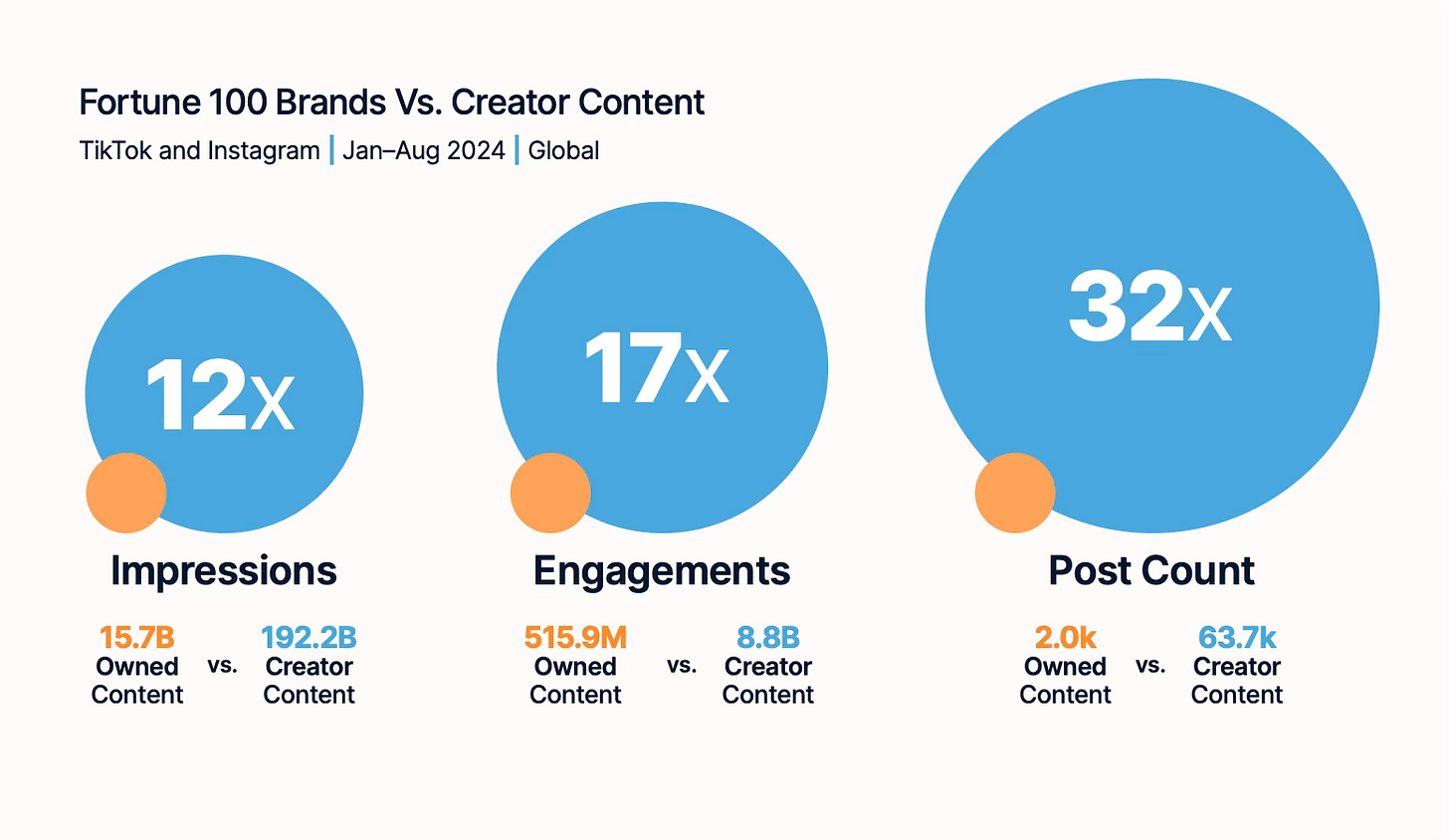Last week, I began exploring the idea that successful creators have become micro-media entrepreneurs.
It struck a nerve, as I’ve had a lot of feedback on it, and am coming back soon with a follow-up interview with a creator who’s launching a full-fledged micro-media brand. Stay tuned.
But for now, it’s whitepaper season! Social and data platforms are dropping their year-in-review and 2025 previews, and there’s a treasure trove of new data out there.
There’s a detail in Creator IQ’s “State of Creator Marketing” report that I think is revealing about how social media works today.
For the Fortune 100 brands in the study, the raw numbers are striking: Creators generated 12 times as many impressions and 17 times the engagement of brand channels in the first 8 months of 2024.
But here's the kicker – it took them 32 times as many posts to get there. That is a huge volume of posting on small channels to generate returns, and it’s the kind of thing that keeps marketing teams up at night questioning their strategy.
But here’s why that shouldn’t be a problem.
Remember, we’re talking about the biggest brands on the planet — Nike, Amazon, Target, Google, Disney — companies with social followings built over decades. They can afford to be reliably mediocre and still generate engagement.
In an algorithm-driven world, volume is the path to victory.
What they can’t afford to do is make mistakes. It’s corporate reality — too much bureaucracy, too much scrutiny and not enough social staff to scale content production anyway. Besides, since brand audiences are basically not growing anymore, oversaturation is a real concern.
The Algorithm Game
So why are they employing creators to post 32 times for every brand post? Because in an algorithm-driven world, volume is the path to victory.
High post volume serves two purposes. First, it lets you test tons of content variations across a variety of audiences. Second, in an algorithm-driven ecosystem where virality matters more than audience size, you need as many shots on goal as possible.
And nothing achieves volume faster than a creator-driven strategy. While the corporate team workshops that one post into utter mediocrity, creators are producing endless streams of content, playing to social trends, often failing, and occasionally striking gold. Either way, they’re staying in front of their audience, even when attention is fractured and fleeting.
At the same time, algorithms show little deference for past success. In a system that favors virality over established audience, you’re only as good as your last post.
I’ve seen posts go so viral that they generate 100x the channel’s average reach, then the next post falls nearly back to baseline.
But don’t downplay the importance of that outlier post. There’s a common sentiment that if a brand can’t predictably replicate virality, it’s not valuable — but that’s just not true. The views and impact are real, and the post might even drive a spurt of follower growth.
Outliers are not aberrations, they’re an integral part of the strategy.
Outliers are not aberrations, they’re an integral part of the strategy.
One-hit-wonders still topped the charts, even if they had to make a lot of music to get a hit. Heck, Chumbawamba has released 14 albums, but there’s only one Tubthumping. (It’s not easy to work Chumbawamba into a post about social media, but there you have it.)
Trust the Creators with their Communities
This will mean loosening the reins. You should still have approval processes, but apply a different filter. The CEO cannot review every post, and someone will make a post that’s right at the edge of brand guidelines. That’s not a problem; consider it the world’s best focus group.
A creator campaign is about letting trusted voices address their audience in words and ways that resonate with the people who follow them. That’s why you hired them. Trust them, and let them run.
Let them pump up the (content) volume and see what goes big.





